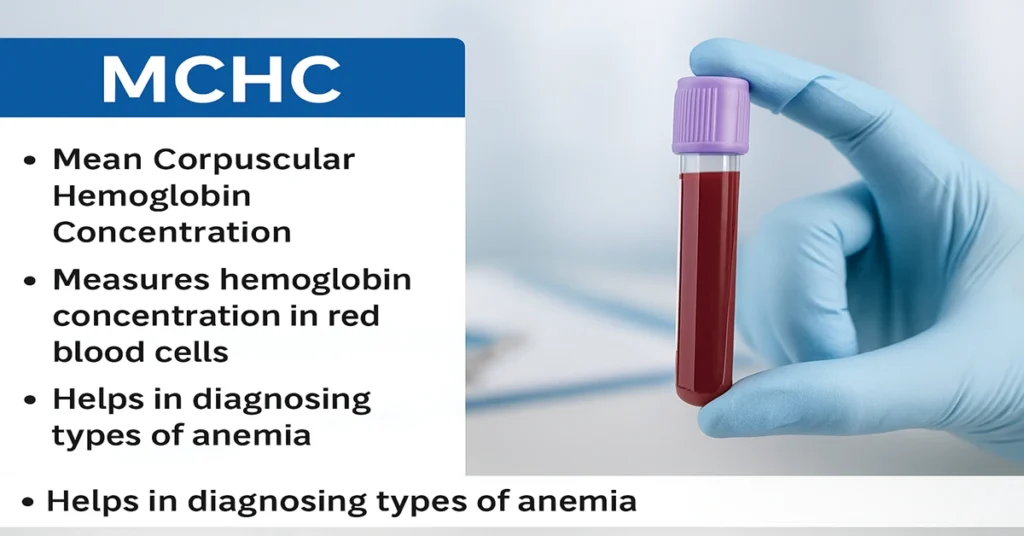What is the MCHC Test?
The MCHC test, or Mean Corpuscular Hemoglobin Concentration test, measures the average concentration of hemoglobin inside your red blood cells (RBCs). Hemoglobin is the protein that carries oxygen throughout the body. While the MCH test shows how much hemoglobin is in each cell, the MCHC test tells you how densely packed the hemoglobin is inside each cell.
This test is a part of the Complete Blood Count (CBC) panel and is important for diagnosing and classifying types of anemia.
Where is MCHC Determined in the Body?
MCHC is a calculated value measured in the lab, not directly produced by the body. It is calculated using:
- Hemoglobin level (g/dL)
- Hematocrit (% of blood volume made up of red blood cells)
Hemoglobin itself is made in the bone marrow when red blood cells are formed. Nutrients like iron, vitamin B12, and folate play a key role in hemoglobin content, which directly affects MCHC values.
Main Functions and Importance of MCHC
Measures Hemoglobin Concentration: Shows whether RBCs are filled with normal, low, or high levels of hemoglobin.
Helps Detect Types of Anemia:
- Low MCHC (Hypochromic): Cells have less hemoglobin than normal, appear pale.
- Normal MCHC (Normochromic): RBCs appear normal but anemia may still be present.
- High MCHC (Hyperchromic): Rare; seen in certain inherited or autoimmune conditions.
Works with Other CBC Values: Doctors use MCHC along with MCV (cell size) and MCH (hemoglobin amount per cell) to pinpoint the exact cause of anemia.
Causes of Low MCHC (Hypochromic Anemia)
When MCHC is below 32 g/dL, it is usually linked to anemia with pale-looking RBCs. Causes include:
- Iron Deficiency Anemia: Most common worldwide.
- Chronic Blood Loss: Heavy periods, ulcers, injuries, or hidden bleeding.
- Thalassemia: Genetic blood disorder affecting hemoglobin.
- Lead Poisoning: Interferes with hemoglobin production.
- Sideroblastic Anemia: Problem in using iron to make hemoglobin.
Symptoms of Low MCHC
- Fatigue and constant weakness
- Pale skin or mucous membranes (lips, gums, eyelids)
- Shortness of breath with activity
- Dizziness or lightheadedness
- Cold hands and feet
- Low oxygen levels causing tiredness
Causes of High MCHC (Hyperchromic Anemia)
High MCHC (above 36 g/dL) is less common than low. Causes include:
- Hereditary Spherocytosis: Genetic condition where RBCs are sphere-shaped.
- Autoimmune Hemolytic Anemia: Immune system destroys red blood cells.
- Severe Burns: Can damage RBCs, raising MCHC.
- Lab Errors: Sometimes incorrect handling of sample falsely increases results.
Symptoms of High MCHC
- Fatigue and tiredness
- Jaundice (yellow skin or eyes) seen in hemolytic anemia
- Dark-colored urine
- Enlarged spleen
- Shortness of breath
- Rapid or irregular heartbeat
Reference Ranges
(may vary slightly by lab)
Normal MCHC: 32 – 36 g/dL
Low MCHC (< 32 g/dL): Hypochromic anemia
High MCHC (> 36 g/dL): May indicate hereditary or hemolytic conditions
Sample Type
- Sample Taken: Whole blood
- Tube Used: Lavender-top EDTA tube
Blood is collected from a vein in your arm and analyzed in the lab as part of a CBC panel.
Test Preparation
- Usually no fasting is required for the MCHC test.
- Drink normal water and stay hydrated.
- Tell your doctor about medications (like chemotherapy or immune-suppressing drugs).
- If anemia is suspected, your doctor may order additional tests such as iron studies, vitamin B12, and folate levels along with MCHC.
When to Consult a Doctor
- If you have long-lasting fatigue or weakness.
- If your MCHC result is consistently low or high.
- If you show signs of jaundice, dark urine, or an enlarged spleen.
- If you have a family history of genetic blood disorders like thalassemia or hereditary spherocytosis.
~END~

